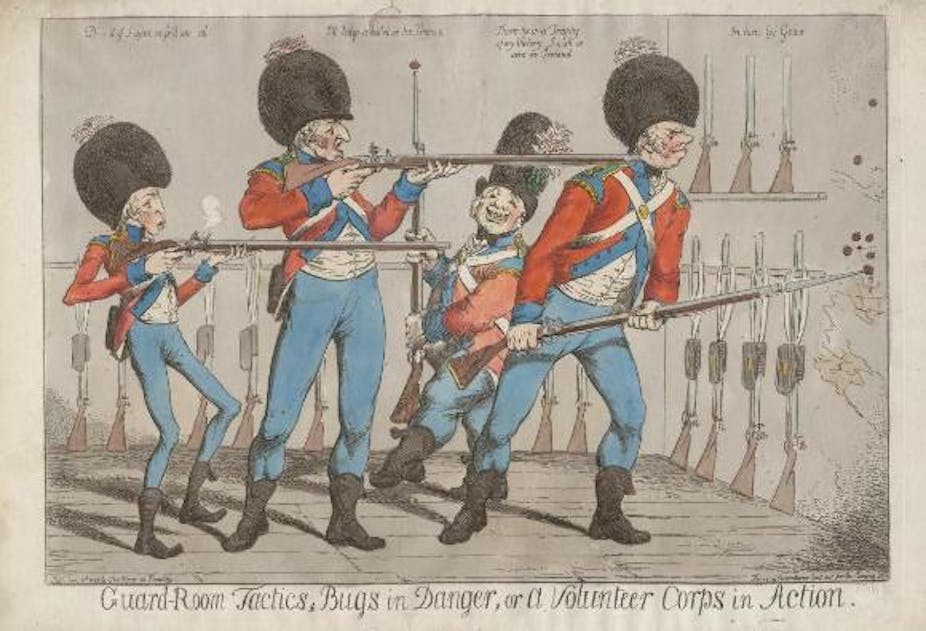In 1810, after seven years of the Napoleonic Wars, the prime minister, Lord Liverpool, penned a memorandum stating that Britain’s military was: “as large a force … as the Population and Finances of the Country could well support”.
The Battle of Waterloo looms large in the public consciousness – and this is only set to grow in the coming months as we head towards celebrations of its 200th birthday. But the mass mobilisation of a generation of men to defend Britain against revolutionary and then Napoleonic France between 1793 and 1815 is overlooked. An astonishing one in four men served in some kind of capacity during these wars, a figure that exceeds those of World War I.
The first Great War
At its peak, there were 250,000 men in the British Army, plus 80,000 serving in the militia, a particular form of home defence force raised during wartime, as well as 140,000 in the Royal Navy. You will find plenty of all these in most Jane Austen novels. These figures were matched by part-time soldiers raised across England, Wales, Scotland and Ireland – there were 450,000 of these during the height of the invasion scare in the run up to the Battle of Trafalgar.

The composition of the Britain’s military was quite different to that in World War I as so many were not in full-time military service but enlisted as part-time soldiers to be used in case of an invasion. As these soldiers were never used in combat, their experience has been mostly forgotten and confined to academic texts.
But the impact of these part-time soldiers, known as Volunteers, was widespread across the UK. They formed the bulk of Britain’s military effort and were established in almost every town across the country. As well as meeting up for training (about 20 days a year), they also became involved in the civic and social life of their areas and their members.
As these soldiers still continued in their civilian lives, they tended to be quite representative of the social make-up of their locality. Sometimes, involvement in the Volunteers was a way to improve one’s social standing.

Other units, especially cavalry (often known as the Yeomanry), were particularly exclusive. The additional cost of the uniforms and equipment of some units, beyond what the government provided, meant that being a member of these units was quite a financial commitment.
Many volunteer units participated in the Royal Jubilee celebrations of 1809. Their activities were frequently reported in newspapers. They regularly appeared at weddings and funerals. Given the numbers involved, there’s a good chance that anyone who had an ancestor in the UK during these wars could find something about them – even if it is just records of them getting paid for their time.
A prototype Dad’s Army
As with many part-time soldiers, it is easy to be disparaging about troops that see no action. So there’s a strong tradition of ridiculing these would-be soldiers, the original Dad’s Army, if you like.
And there were certainly comical elements to their history. They were often satirised in contemporary prints about their heightened concern with their uniforms and distinctly un-martial qualities.
The Loyal Hackney Volunteers’ uniform included a bearskin hat with a feather, and bespoke buttons inscribed with “Loyal Hackney Volunteers”. Volunteers chose more expensive cloth and colours for their coats too – the Sussex Yeomanry selected a dark green jacket with black velvet collar and cuffs.

Indeed, there is good evidence in local archives for the Volunteers spending a lot of time, and money, on their uniforms. An example comes from Carlisle record office, concerning an officer who had been rather ambitious with the measurements for his uniform breeches and had to send them back as they were too tight for him to wear.
But there is a serious point to their overly zealous attention to their uniforms. In the absence of an overt military role – they were waiting for an invasion that in the end never occurred – other ways were sought to define themselves as soldiers and distinguish them from the civilian population.
Their outward appearance, at least for a few days a year, and public display in uniform became the means to do this. Outside of the big garrisons in London, Edinburgh, and Dublin, parades were rare before the 1790s, but this changed during the war. Ostentatious military display became, and remains, an important way for the public to recognise men in military roles.
After 1815 these part-time soldiers were not needed anymore and units were disbanded. Gradually they passed from an ever-present component of British life into obscurity. The relief at the ending of the wars in 1815, and the public celebrations and memorials focusing on the great battles of the conflict, meant that the Volunteers were largely ignored.
But for a long time these peacocking soldiers were an everyday part of life – and for all their lack of real fighting, they transformed the military into something we would recognise today.

